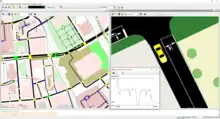Simulation of Urban MObility
Simulation of Urban MObility (Eclipse SUMO or simply SUMO) is an open source, portable, microscopic and continuous multi-modal traffic simulation package designed to handle large networks. SUMO is developed by the German Aerospace Center and community users. It has been freely available as open-source since 2001, and since 2017 it is an Eclipse Foundation project.
 | |
| Developer(s) | German Aerospace Center |
|---|---|
| Initial release | 2001 |
| Stable release | 1.18.0[1]
/ 29 June 2023 |
| Repository | |
| Written in | C++, Java, Python |
| License | Eclipse Public License |
| Website | eclipse |
Purpose
Traffic simulation within SUMO uses software tools for simulation and analysis of road traffic and traffic management systems. New traffic strategies can be implemented via a simulation for analysis before they are used in real-world situations.[2] SUMO has also been proposed as a toolchain component for the development and validation of automated driving functions via various X-in-the-Loop and digital twin approaches.[3][4]
SUMO is used for research purposes like traffic forecasting, evaluation of traffic lights, route selection, or in the field of vehicular communication systems. SUMO users are able to make changes to the program source code through the open-source license to experiment with new approaches.
Projects
SUMO was used in the following national and international projects:
- AMITRAN,[5] a CO2 assessment methodology achieved by ICT applied to the transport sector via intelligent transportation systems (ITS).
- COLOMBO[6]
- CityMobil,[7] a project for integration of automated transport systems in the urban environment. Completed in 2011.
- DRIVE C2X[8]
- iTETRIS[9]
- Soccer[10] traffic data collection from the air during the 2006 FIFA World Cup football championship
- VABENE[11] project to improve safety at mass events.
See also
References
- Error: Unable to display the reference properly. See the documentation for details.
- Tonguz, Ozan K. (25 Sep 2018). "How Vehicle-to-Vehicle Communication Could Replace Traffic Lights and Shorten Commutes". IEEE Spectrum.
- "Simulation-Based Identification of Critical Scenarios for Cooperative and Automated Vehicles (2018-01-1066 Journal Article)- SAE Mobilus". saemobilus.sae.org. Retrieved 2020-02-03.
- Weber, Nico (January 2020). "AmE - Automotive meets Electronics 2020: A simulation-based, statistical approach for the derivation of concrete scenarios for the release of highly automated driving functions". Researchgate. Retrieved 2020-02-15.
- "AMITRAN". Archived from the original on 2012-09-28.
- "COLOMBO Project". Archived from the original on 2013-05-15.
- "CityMobil". Archived from the original on 2019-12-04.
- "Drive C2X". Archived from the original on 2012-06-15.
- "iTetris Project Consortium". 2008. Archived from the original on 2010-08-15.
- "Soccer - traffic data collection from the air during the World Cup". Archived from the original on 2016-12-18.
- "vabene" (in German). Archived from the original on 2011-07-18.
Notes
- Alvarez Lopez, Pablo; Behrisch, Michael; Bieker-Walz, Laura; Erdmann, Jakob; Flötteröd, Yun-Pang; Hilbrich, Robert; Lücken, Leonhard; Rummel, Johannes; Wagner, Peter; Wießner, Evamarie (2018), "Microscopic Traffic Simulation using SUMO", IEEE Intelligent Transportation Systems Conference (ITSC)
- Krajzewicz, Daniel; Erdmann, Jakob; Behrisch, Michael; Bieker, Laura (December 2012), "Recent Development and Applications of SUMO - Simulation of Urban MObility" (PDF), International Journal On Advances in Systems and Measurements, vol. 5, no. 3&4, pp. 128–138, archived from the original (PDF) on 2013-09-18